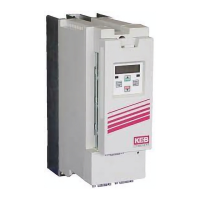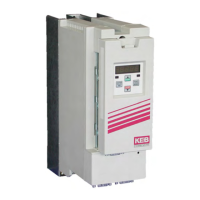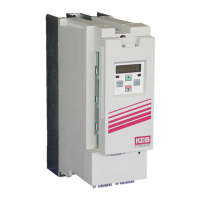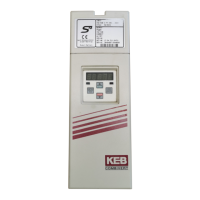6 4
KEB COMBIVERT F5-G / B
12
Name: Basis
06.02.02
© KEB Antriebstechnik, 2002
All rights reserved
Functional Description Set Value and Ramp Adjustment
Chapter Section Page Date
(oP. 10)
-100% +100%
(oP.14)
+f [Hz]
-f [Hz]
(oP.11/oP.15)
The unit differentiates between two setpoint adjustments:
- the setpoint adjustment
With the adjusted setpoint limits the frequency range 0%...100% is defined.
in this case the adjustment 0% corresponds to the minimal frequency and
100% to the maximal frequency. The frequency is calculated according to
following formula:
positive setpoint [Hz] = oP.6 + (setpoint adjustment [%] x
oP.10-oP.6
)
100%
negative setpoint [Hz] = oP.7 + (setpoint adjustment [%] x
oP.11-oP.7
)
100%
The frequency is limited through the corresponding maximal frequencies.
- the absolute setpoint adjustment, i.e. the setpoint is directly adjusted as
frequency and limited through the corresponding minimal and maximal
frequencies as well as through the absolute maximal frequency.
The setpoint sources are assigned as follows:
Setpoint adjustment in percent Absolute setpoint adjustment
Terminal strip (analog setpoint) Keyboard/Bus absolute
Keyboard/Bus in % Set speed value SY.52
Motorpoti Speed detection
PID-controller
6.4.6 Setpoint
Computation
Fig. 6.4.5.a Setpoint limits
Setpoint[%]
Setpoint [%]
Maximal frequency
forward
Absolute maximal frequency
forward
Maximal
frequency reverse
= abs. max.
frequency reverse

